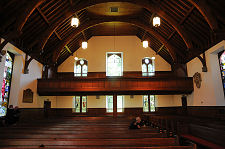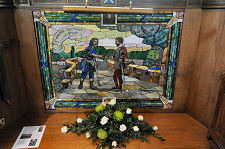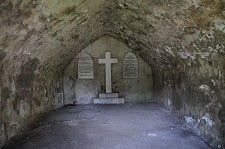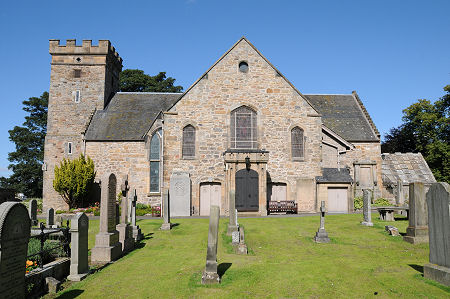 Cramond Kirk from the South |
Cramond Kirk stands in the village of Cramond a hundred yards or so south of the car park which serves the best known and most visited part of the village, its northern end where the River Almond flows into the sea beside the tidal causeway leading out to Cramond Island.
The kirk is a popular one with a large and active congregation that seems very successfully to buck the trend found more generally in 21st Century Scotland of diminishing church attendances. For more casual visitors the striking thing is the enthusiasm and commitment of those involved in the kirk, as well as the attractiveness of the building itself. When the kirk itself is not open to visitors, the kirkyard is worth seeing in its own right.
The origins of Cramond Kirk date back to the building here of an extensive Roman Fort to support the invasion of northern Britain by Roman Emperor Septimius Severus in AD208, on the site of a smaller fort built here during an earlier Roman incursion in AD142. The Romans abandoned Cramond, and Scotland, in AD212, leaving a very significant settlement behind them which continued in use by the local population. By about 600 a building on the site of part of the Roman Fort was being used for Christian worship. The site has been continuously occupied as a place of worship, and the church you see today, which stands in the heart of the area once occupied by the Roman Fort, is only the latest in a series which have probably stood on or close to the same spot.
The earliest part of the church which survives today is the tower at its west end, which is thought to date back to the 1400s. Possibly of similar date is the Inglis family vault at the east end of the kirk, complete with a stone slabbed roof. Most of the church between these two extremities dates back to 1656. By then, nearly a century after the Reformation, the medieval church on the site had fallen into ruin and would doubtless have been structurally ill-suited to the needs of the Presbyterian Kirk and its very different forms of worship. The result was the near complete rebuilding of the kirk.
Further changes and refurbishments have been made a number of times since. In 1828 the architect William Burn altered the church, while David Bryce oversaw changes in 1851 and 1868. Further major changes took place in 1911-12, which included the near total remodelling of the interior of the kirk and the alteration and refurbishment of a structure which had become very dilapidated. Cramond Kirk as you see it today effectively dates back to the changes concluded in 1912.
The bell at Cramond Kirk predated the 1656 rebuild of the church, but was nearly lost altogether. In 1651 Cromwell's occupying army removed the bell from the nearly ruined church, presumably with the intention of melting it down for its metal. An appeal to General George Monck resulted in the return of the bell.
The interior of the kirk is much more roomy than you expect from outside, and the most striking feature is the large amount of attractive woodwork on view lining the ceiling, panelling the lower parts of the walls, and in the pews and galleries. The focus of attention is the pulpit and communion table placed, unusually, at the kirk's south end.
The kirk is a commodious one, and the accommodation is increased further by the provision of galleries on all four arms of the structure. Some of these, such as the Barnton Gallery and the Cramond Gallery, were used by local lairds and their families.
A tour of Cramond Kirk is full of fascinating detail. There are a number of fine stained glass windows, though the most interesting are also the easiest to overlook. Below the North Gallery are four windows depicting the lives of four notable saints, St Andrew, St Cuthbert, St Columba and St Margaret. Also easy to overlook is the mosaic memorial to Jock Howieson. Jock was a peasant living in Cramond who intervened to prevent a stranger being attacked by robbers while crossing Cramond Brig. The stranger turned out to be King James V in disguise, and Jock was granted estates in the area as a reward.
There are a number of fascinating old gravestones in the Kirkyard, with perhaps the most striking being that of Robert Haig, which appears to carry a depiction of two nuns.
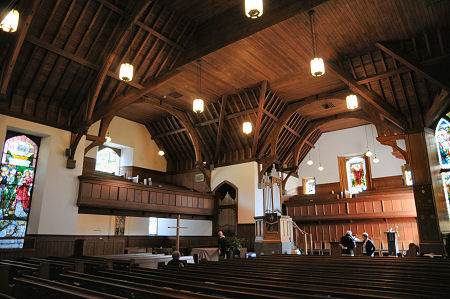 The Magnificent Interior of the Kirk |

|
|
|
Visitor InformationView Location on MapCramond Glebe Road, Edinburgh, EH4 6NS. Tel: 0131 336 2036. Grid Ref: NT 190 769 www.cramondkirk.org.uk What3Words Location: ///leans.pencil.filer |
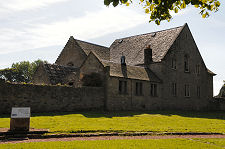 The Rear of the Kirk from the Fort |
 The Session House |
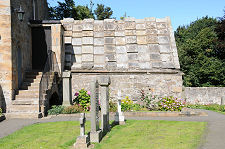 Burial Aisle |
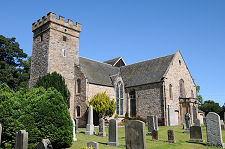 The Kirk from the South-West |
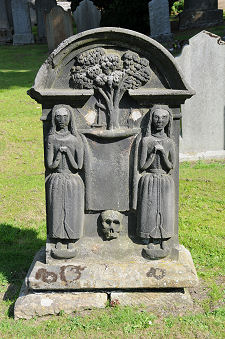 Gravestone of Robert Haig |


